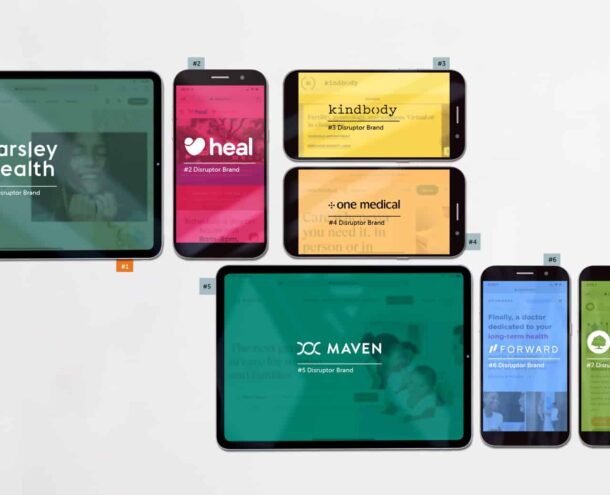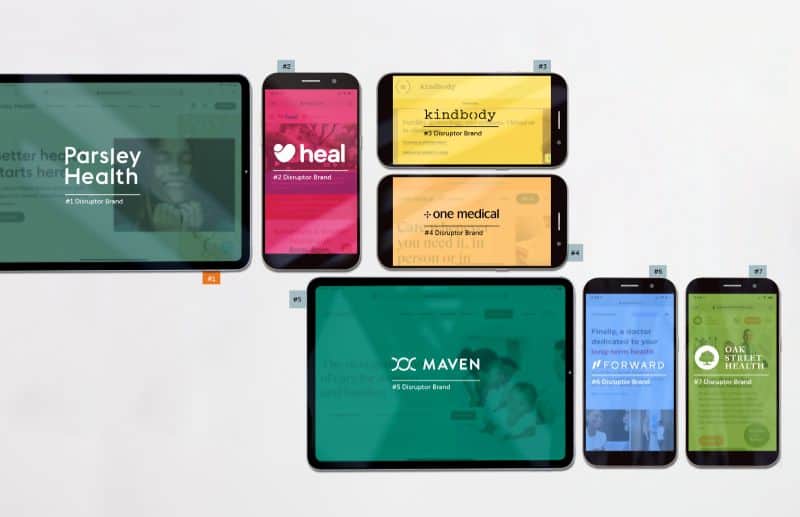Meet the Disruptors: Spotlight on Heal

Kylie McCalmont and Danielle Tieman (Strategy) teamed up to take a deeper look into the disruptor brands shaking things up in healthcare.
In our Humanizing Brands Experience Vol 4 report, we explored how the chaos and uncertainty of the last year set the scene for disruptor healthcare brands to continue their rise to the top. If you weren’t already paying attention to innovators like Parsley Health, Heal, Kindbody and more, this year’s findings should wake you up. In a stunning ascent, all but one of the top seven disruptor brands we explored performed more strongly than the leading healthcare brand Johns Hopkins in overall brand experience ratings.

Healthcare leaders, take note. These disruptor brands are succeeding where others fail because they’ve implemented an adaptable, consumer-driven, and technology-led approach from day one. Unless traditional healthcare brands can pivot and shift to keep up, these newcomers are poised to take over consumer choice, usage and preference as their target audiences continue to expand.
In this post, we’re going deep with #2 ranked disruptor brand Heal. In addition to exploring the humanizing innovations that have helped propel Heal into a leading spot in overall brand experience rankings, we’ll break down some of the key takeaways that healthcare brands of all kinds can—and should—learn from this disruptor’s example.
Meet the disruptor
Heal is a national healthcare provider that brings timely, affordable primary care into the safety and comfort of patients’ own homes. Specializing in in-home visits, Heal brings a classic approach to healthcare back to life for a new generation. In addition to less hassle and added convenience for patients, in-home and telemedicine visits allow Heal doctors to develop a more complete, holistic understanding of patients’ lives and health needs.
For example, when conducting in-home care, Heal providers may offer to review patients’ pantries when discussing diet and nutrition. With easy access to fridge contents, as well as current prescriptions and vitamins, these in-home visits offer an opportunity for providers to help patients fully understand their current care routines in a level of detail that’s simply not possible within the four walls of a doctor’s office.
What else is new?
Recognizing that health doesn’t always follow a schedule, Heal appointments are offered same-day, seven days a week, 365 days a year. Patients can schedule appointments and visits through a simple app that shares a transparent view of their doctor’s calendar, empowering patients to select the time that works best for them. The discomfort of traditional waiting rooms is eliminated, as patients are free to wait in the comfort of their own homes for their appointment to begin.
Perhaps most innovative of all, Heal provides patients with a clear breakdown of the full cost of an appointment before it even takes place. It’s highly personalized care, delivered with ease, convenience, and transparency—all key factors in humanizing the healthcare experience.

Key takeaways
We know that not every healthcare brand is set up to adopt the practices Heal was designed for overnight. But we can all still benefit and learn from the way Heal is challenging traditional pain-points through a people-centric approach to experience.
Use these examples as conversation starters in your next brand and experience-focused meeting. What can we learn from this disruptor’s approach? And how might those learnings shift our own brand experience in a new direction?
1. Reimagine the Waiting Room
One of the most significant benefits provided by Heal is replacing the waiting room with the living room. No more languishing in uncomfortable furniture in a germ-filled room of strangers. With Heal, patients are free to wait for their appointments to start in the comfort and security of their own home.
Learn More: Bringing Brand to Life in Physical Spaces
While we may not be able to provide the same solution, we can start posing the question – how can we make our virtual and physical waiting experiences better for people?
Thought starters:
-
-
-
-
- Explore making our waiting rooms feel more like an inviting family room rather than a sterile ward. How would that change the way our current waiting room environments look, feel, sound, or even smell? Consider all the sensorial ways a patient experiences their surroundings.
- Create more choice for patients in waiting rooms to allow them some of the freedom and autonomy they might experience in their own homes? What about offering patients a selection of waiting spaces tailored for different uses, such as productivity, relaxation, or exercise?
- Think about idle time in new ways—especially related to virtual appointments. Can we improve or enhance virtual waiting rooms by offering information, games, health quizzes, or branded interactions to help people pass the time? Offering opportunities to fill time by filling out health-related questionnaires that can be shared with their doctor could help make both wait-times and appointments more productive and meaningful.
-
-
-
2. Simplify Scheduling
Heal gives patients access to something that many have never seen before: a firsthand look at their doctor’s schedule. This information, while closely guarded at traditional care providers, is displayed clearly and transparently on an app for Heal patients to view.
This “radical” act of transparency tells patients that their time is valuable too—and that they are important enough to place time on their physician’s calendar. It also streamlines the scheduling process for patients and Heal staff alike.

Not every provider has the set-up to make calendars fully transparent. Still, how can this inspire us to start making appointment scheduling more easily accessible and flexible for our patients?
Thought starters:
-
-
-
- Consider allowing patients to have greater visibility to their physician’s schedules. How could that come to life within our current systems and processes? The cultural implications are far-reaching, but the era of being people-first is real.
- Give people a sense of transparency and choice by sharing a selection of appointment openings that they can pick and choose from at their leisure. Why should choice be something that only providers get?
- Rethink our processes and approaches in a way that challenges the typical. By forcing patients to call and ask a receptionist for an appointment, it can make people feel as if we are the gatekeepers to their doctor and access to care. How can we prioritize addressing this gap, and giving patients more options that make them feel like a top priority?
-
-
3. Be Clear About Cost
Heal makes a point to inform patients about the full cost of their appointment before it’s even booked. For patients with insurance, out-of-pocket costs are shown before the appointment is scheduled. Without insurance, patients are charged a simple flat fee. This approach ensures patients are never surprised by or confused about what to expect. Costs are made clear, easy to understand, and fully transparent from the very start.
Learn More: 3 Strategies for Building Consumer Trust (And What to Do if You’ve Lost It)
Compare that to the standard billing experience at most traditional healthcare brands, and the differences are stark. Ask yourself and your team, are we delivering the same level of cost security, confidence, and understanding for our patients?
Thought starters:
-
-
-
- Adopt a similarly transparent approach by committing to cost clarity pre-appointment. Price transparency is the expectation in just about every other industry—it’s time for us to become contributors to clarity vs. confusion. What traditional barriers or roadblocks might get in the way for us—and how could we overcome them?
- Provide clarity during a follow-up message shortly after the appointment takes place if we cannot always share full, transparent costs pre-appointment. This further demonstrates our follow-through and eagerness to build confidence in what’s ahead even beyond the care plan. How can we make the process as painless and seamless as possible?
-
-
The disruptors are challenging the expectations of our industry, and the team at Heal can serve as an inspiration and a provocation if we leverage their actions to ask the right questions within our own organizations.
Interested in learning more about the disruptors and what we can learn from them? Become a member of our next Humanizing Brand Experience report! As a member you’ll receive a personalized dashboard of your brand data + any 3 competitors of your choice, first access to the Vol 5 report, you’ll become part of a collective of industry peers and experts fueling healthcare’s evolution, and so much more!


